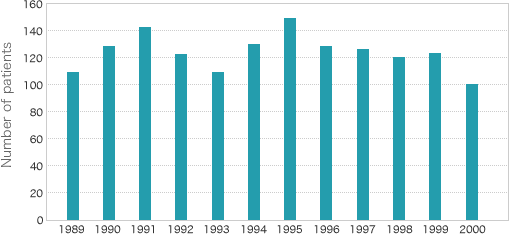![]()
Early detection and surgical treatment within 2 months after birth
The pathway for the flow of the bile that has been produced in the liver to the intestinal tracts is denoted as the bile passage or the biliary duct. If the flow of the bile through the bile passage or the biliary duct is blocked congenitally or due to some reason, soon after birth, cholestasis occurs in the liver, and the bile flows back into the blood, causing jaundice and the feces become whitish in color.
Under such conditions, the functions of the liver cannot be recovered, and it gradually becomes hard, leading to liver cirrhosis and finally to death; this is biliary atresia, a dreadful disease. Biliary atresia is one of intractable pediatric diseases, being said to occur at the incidence of 1/10,000. According to the nationwide registration in Japan, about 100 babies have this disease every year.
Usually, the prognosis of biliary atresia is bad in many cases, unless detected early after birth and treated with surgery within 2 months. After duration of 2 months, even if the bile can flow out by surgical treatment, the disease condition has already progressed to the stage of liver cirrhosis, and after-effects are unavoidable in such cases.

| 1989 | 1990 | 1991 | 1992 | 1993 | 1994 | 1995 | 1996 | 1997 | 1998 | 1999 | 2000 |
|---|---|---|---|---|---|---|---|---|---|---|---|
| 108 | 127 | 142 | 122 | 109 | 129 | 147 | 129 | 126 | 120 | 124 | 100 |
Number of registered cases of biliary atresia (from 1989 to 2000)
Screening of neonates with difficulty in blood collection
Although it has been recognized that the prognosis of biliary atresia is somewhat promising when appropriate surgery and control have been made within 2 months after birth, practically no trend of early detection has been found.
The paper published in England in 1995 reported, "Despite the 15-year education in the past, about 50% of children with this disease are still referred to specialists after duration of over 6 weeks after birth," emphasizing that early detection was very important, and at the same time that some sort of screening was necessary.
It has been found by the studies made so far that urinary sulfated bile acid (USBA) is increased in cases of biliary atresia; therefore, its assay has been considered to be an effective test method for early detection of biliary atresia in neonates with difficulty in blood collection.






